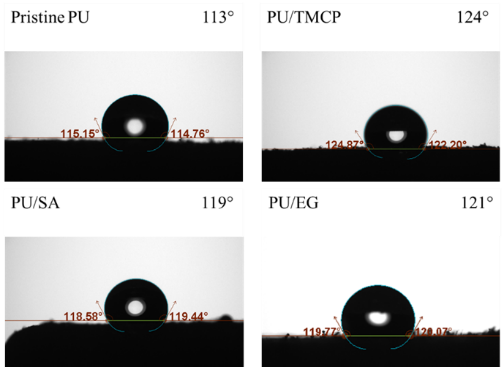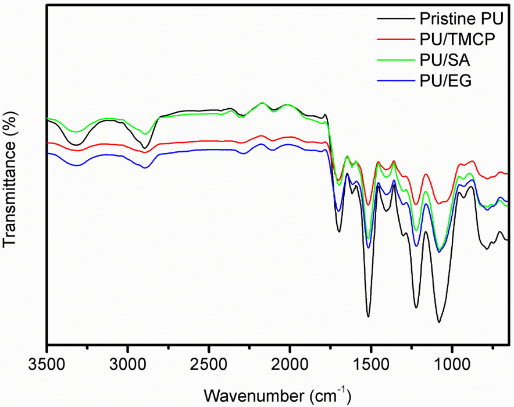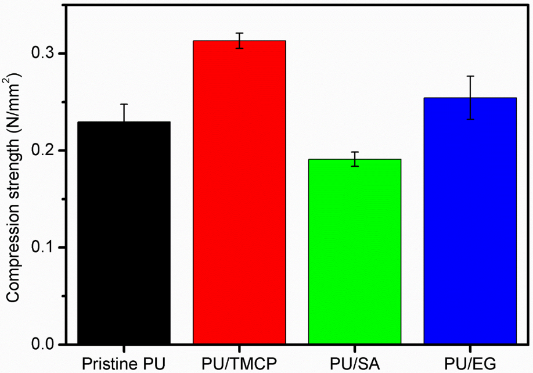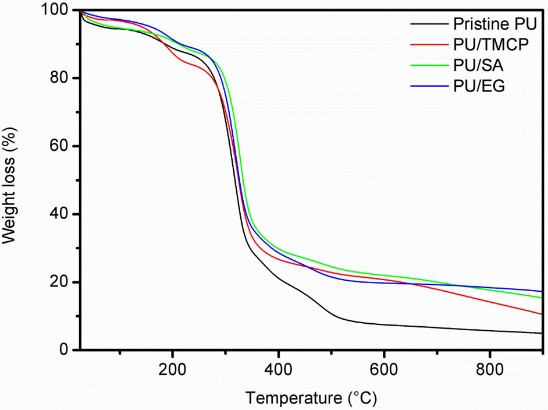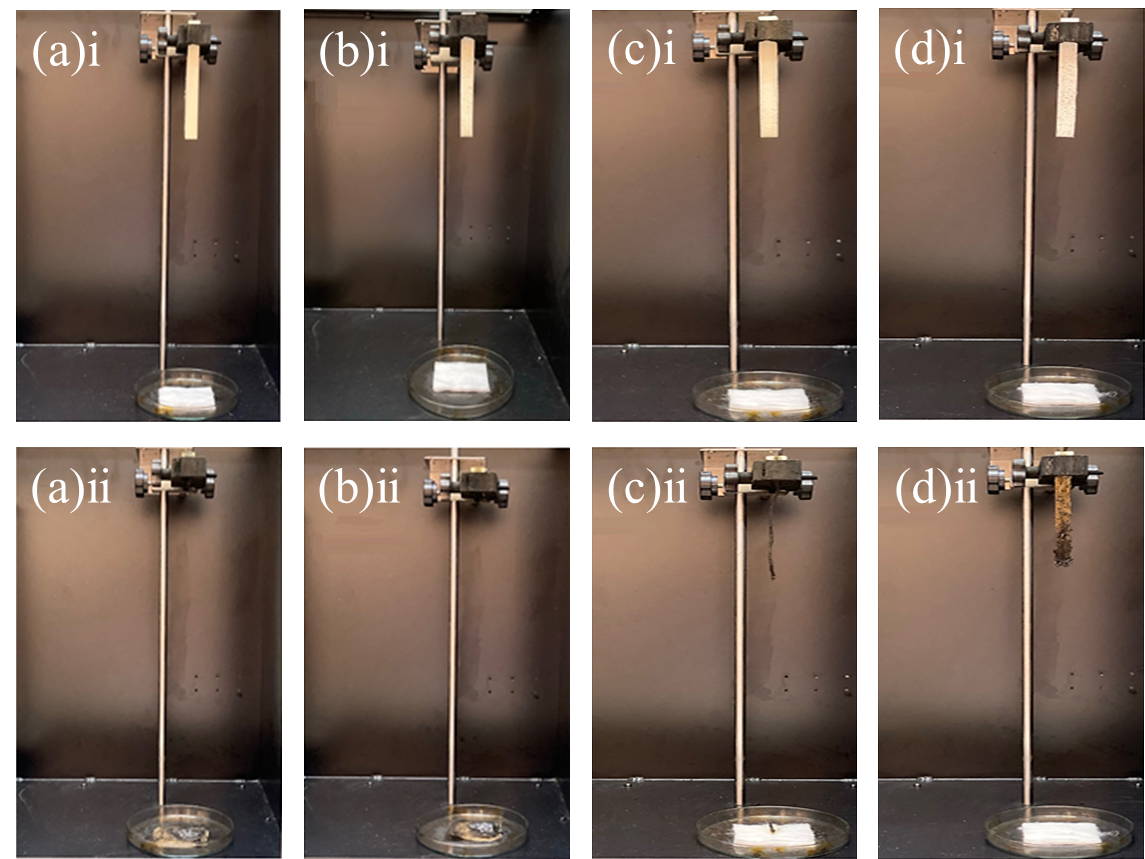Abstract
Although rigid polyurethane foams (RPUFs) have great thermal insulating properties, they have limited usage because pristine PU foams are highly flammable. Therefore, in order to have widespread applications, much attention has been invested in the discovery and study of a vast number of flame retardants. Though there have been countless reports of novel flame retardants, it has been a challenge to select the most appropriate flame retardant for the RPUF of interest. While several comparison studies have been documented in the literature, the focus is on the microstructure, mechanical, and thermal properties. Herein, a relatively comprehensive flame retardant selection process is introduced, which includes more physical and chemical properties characterisations, enabling one to make informed decisions when selecting flame retardants.
Keywords
Polyurethane foam, Flame retardant, Microstructure, Mechanical, Thermal properties
Introduction
Polyurethane (PU) foam is synthesised via a polymerisation reaction of polyol and isocyanate, in the presence of various formulations of catalysts and surfactants [1]. For this reason, depending on the composition, PU foam can be tailor-made into flexible foams, semi-rigid foams, and/or rigid foams, resulting in a wide range of products with unique properties [2].
As an example, rigid polyurethane foams (RPUFs) generally display high specific strength, are lightweight, and are suitable for thermal, acoustic, and electric insulation [2]. Thus, RPUFs are used extensively in numerous fields and with a broad range of applications, such as in construction, automotive, furniture and household appliances, and packaging [1]. Despite these advantages, the high flammability of pristine RPUFs due to the high carbon and hydrogen content [3] presents a significant obstacle, which greatly limits their application. Therefore, a productive way of enhancing their flame resistance is via the addition of flame retardants into the RPUFs [3].
Hence, in this commentary, we compare the classes of flame retardants, and discuss in particular, the flame retardant selection process for RPUF.
Types of Flame Retardants
In the plastics industry, it is common to incorporate various additives into the polymer blend, in order to enhance/impart desired characteristics to the final product. Flame retardants that are chemically bonded to the polymer matrix, are known as reactive flame retardants; while those that are added into the polymer mix, are known as additive flame retardants. As reactive flame retardants are generally custom synthesised for the specific polymer matrix, a reactive flame retardant that works well for a certain type of polymer might not work for another type of polymer.
Consequently, in view of its relative versatility and cost-effectiveness, additive flame retardants are one of the important additives being added into the polymer mixture to inhibit or resist the spread of fire.
Since the early 1930s, halogenated flame retardants [4-6] have been industrially recognised and commonly used due to its low cost, ease of processability, and with little or no reduction in the intrinsic physical/mechanical properties of the RPUF [1]. However, due to serious concerns about their toxicological and environmental impact, usage of halogenated flame retardants has been restricted in many countries, such as the EU and US [7]. As a result, enormous research effort has been invested in the development of non-halogenated flame retardants.
To date, there have been extensive reports on numerous classes of non-halogenated flame retardants, such as minerals [8-10], phosphorus/nitrogen based compounds [11-16], intumescent agents [17-21], boron based compounds [22-24], nanofillers [25-29], as well as the incorporation of silica aerogel [30-32] into RPUFs.
Challenges Faced in the Flame Retardant Selection Process
Ideally, the incorporation of flame retardant additives should not be at the expense of the other outstanding properties of RPUF. However, with a myriad of promising flame retardants being reported, and as some come with its own set of advantages and disadvantages (such as increased flame retardance at the cost of lower mechanical strength), it is sometimes difficult to make informed decisions about choosing the most appropriate flame retardant for the RPUF in question. Therefore, it is pertinent to perform comparative studies on the effect of the various flame retardants for the same type of RPUF, in order to reduce the number of variables, for a clearer comparison.
Expandable graphite (EG), being one of the more favourable intumescent agents, has been evaluated against other types of flame retardants, such as hollow glass microspheres [33], decabrominated diphenyl ethane (DBDPE) [34], ammonium polyphosphate (APP) [35], and multi-walled carbon nanotubes (MWNT) [36]. Besides MWNT, other nanofillers that have been analysed include titania and halloysite clay nanotubes [26]. While these previous attempts at comparison focus mainly on the microstructure, thermal, and mechanical properties, it is crucial that the other exceptional RPUF properties (such as its low water absorption and low water permeability), are not missed out so that the comparison is more inclusive.
Selecting the Appropriate Flame Retardant
Recently, Thong et al. [37] described a broader comparison study of several established flame retardants, such as halogenated tris(2-chloroisopropyl) phosphate (also known as TMCP or TCPP), intumescent EG, and silica aerogel (SA).
Other than the characterisations performed to determine the microstructure, mechanical, and thermal properties of the RPUF, the study was also supplemented with the inclusion of water contact angle measurements to determine the surface wettability of the RPUFs (Figure 1). While pristine PU is hydrophobic (with a contact angle of 113°), addition of the studied flame retardants further enhanced the hydrophobicity by 6 – 11°. Not only does this imply that all the flame retardants added are intrinsically hydrophobic, but also addition of the flame retardants provided the added benefit of enhancing the hydrophobicity of the composite.
Figure 1. Surface wettability of RPUF samples. Figure is reproduced with permission [37].
In addition, Fourier transform infrared spectroscopy (FTIR) with attenuated total reflection mode was used to determine the interfacial chemical bonding between the RPUF matrices and additives (Figure 2). Since the FTIR spectra of the foam samples were almost unchanged, it can be inferred that the chemical structures of the RPUF were not affected by the inclusion of the various additives [38].
Figure 2. FTIR spectra of RPUF samples. Figure is reproduced with permission [37].
The addition of TMCP and EG was observed to have a positive effect of increasing the compression strength of pristine PU by approximately 35% and 10% respectively; possibly due to the increase in viscosity of the PU blends, which stabilised the structure of the resulting foam [21]. On the other hand, the compression strength of the PU/SA sample was found to decrease by 17% relative to pristine PU; postulated to be due to the absorption of the PU precursors by the SA [39], which inevitably altered the mixing ratio, reduced the crosslinking density of the polymer matrix, and resulted in diminution of the compression strength.
By heating at 10°C/min from 25–900°C in an inert environment, the initial weight loss up to 287°C, indicated the removal of moisture and other volatiles present in the RPUF samples. While significant weight loss observed between 287–425°C was primarily due to degradation of the samples, it is obvious that EG and SA are better at decelerating the degradation rate (compared to TMCP), from the relatively higher char yield at 900°C.
Photographs of the RPUF samples before and after the vertical burning tests provide a visual comparison of the flammability of the samples. Upon ignition, pristine PU burned rapidly with flaming drips, lighting the cotton indicator below, and showed a V-2 rating (Table 1). While the PU/TMCP sample seemed to display better thermal stability relative to pristine PU according to the thermogravimetric data, it yielded no improvement in the flame retardance (with the cotton indicator similarly ignited by flaming drips), and likewise recorded a V-2 rating. On the other hand, ignition of both the PU/SA and PU/EG samples did not produced flaming drips, which exhibited enhanced flame retardance, and logged a V-1 and V-0 rating respectively. For the PU/SA sample, improved flame retardance relative to pristine PU, was due to the formation of a more rigid and compact silica-rich hybrid char by the SA [40], while the excellent flame retardant properties of EG was due to the formation of a graphite worms char layer on the foam surface that acts as a barrier to retard the spread of fire.
Hence, together with the compression strength (Figure 3), thermal stability (Figure 4), and flammability (Figure 5, Table 1) test results, it is possible to come up with a comparison table (Table 2) and be able to select the best flame retardant with greater confidence.
Figure 3. Compression strength of RPUF samples. Figure is reproduced with permission [37].
Figure 4. TGA thermogram curves of RPUF samples. Figure is reproduced with permission [37].
Figure 5. RPUF samples of pristine PU (a), PU/TMCP (b), PU/SA (c), and PU/EG (d), before (i) and after (ii) vertical burning tests. Figure is reproduced with permission [37].
| Sample | UL-94 classification | Presence of flaming drips |
|---|---|---|
| Pristine PU | V-2 | Yes |
| PU/TMCP | V-2 | Yes |
| PU/SA | V-1 | No |
| PU/EG | V-0 | No |
| Sample | Surface wettability | Compression strength | Thermal stability | UL-94 rating |
|---|---|---|---|---|
| PU/TMCP | Yes | Yes | Yes | No |
| PU/SA | Yes | No | Yes | Yes |
| PU/EG | Yes | Yes | Yes | Yes |
| Yes: represented enhanced performance, No: represented reduced/comparable performance. | ||||
Conclusion
In summary, the inclusion of more physical and chemical properties characterisations, makes contrast between the flame retardants distinct. Thus, ensuring that the selected flame retardant is the one that has the best overall performance.
Of the studied flame retardants, EG exhibited enhanced flame retardance without compromising the other outstanding properties of RPUF, making its reputation as the more favourable intumescent well deserved. On the other hand, while the highly touted SA demonstrated better flame retardance relative to TMCP, it did not outperform EG, losing out in terms of reduced compression strength. Although it might be possible to modify the SA such that absorption of the PU precursors does not occur, more work is still required to determine if modifying the SA makes it surpass EG as the better flame retardant.
Acknowledgements
A MOE Translational R&D and Innovation Fund (TIF) from the Ministry Of Education supported this work (MOE2018-TIF-1-G-031).
References
2. Zhang G, Zhang Q, Wu Y, Zhang H, Cao J, Han D. Effect of auxiliary blowing agents on properties of rigid polyurethane foams based on liquefied products from peanut shell. Journal of Applied Polymer Science. 2017 Dec 20;134(48):45582.
3. Zhang G, Lin X, Zhang Q, Jiang K, Chen W, Han D. Anti-flammability, mechanical and thermal properties of bio-based rigid polyurethane foams with the addition of flame retardants. Royal Society of Chemistry Advances. 2020;10(53):32156-61.
4. Lounis M, Leconte S, Rousselle C, Belzunces LP, Desauziers V, Lopez-Cuesta JM, et al. Fireproofing of domestic upholstered furniture: Migration of flame retardants and potential risks. Journal of Hazardous Materials. 2019 Mar 15;366:556-62.
5. Davesne AL, Jimenez M, Samyn F, Bourbigot S. Thin coatings for fire protection: An overview of the existing strategies, with an emphasis on layer-by-layer surface treatments and promising new solutions. Progress in Organic Coatings. 2021 May 1;154:106217.
6. Zhang Z, Li D, Xu M, Li B. Synthesis of a novel phosphorus and nitrogen-containing flame retardant and its application in rigid polyurethane foam with expandable graphite. Polymer Degradation and Stability. 2020 Mar 1;173:109077.
7. Tsuyumoto I. Flame-retardant coatings for rigid polyurethane foam based on mixtures of polysaccharides and polyborate. Journal of Coatings Technology and Research. 2021 Jan;18(1):155-62.
8. Chai H, Duan Q, Jiang L, Sun J. Effect of inorganic additive flame retardant on fire hazard of polyurethane exterior insulation material. Journal of Thermal Analysis and Calorimetry. 2019 Mar;135(5):2857-68.
9. Akdogan E, Erdem M, Ureyen ME, Kaya M. Rigid polyurethane foams with halogen-free flame retardants: thermal insulation, mechanical, and flame retardant properties. Journal of Applied Polymer Science. 2020 Jan 5;137(1):47611.
10. Agrawal A, Kaur R. Effect of Nano Filler on the Flammability of Bio-Based RPUF. Integrated Ferroelectrics. 2019 Oct 13;202(1):20-8.
11. Liu X, Salmeia KA, Rentsch D, Hao J, Gaan S. Thermal decomposition and flammability of rigid PU foams containing some DOPO derivatives and other phosphorus compounds. Journal of Analytical and Applied Pyrolysis. 2017 Mar 1;124:219-29.
12. Liu SH, Kuan CF, Kuan HC, Shen MY, Yang JM, Chiang CL. Preparation and flame retardance of polyurethane composites containing microencapsulated melamine polyphosphate. Polymers. 2017 Sep;9(9):407.
13. Liu L, Wang Z. High performance nano-zinc amino-tris-(methylenephosphonate) in rigid polyurethane foam with improved mechanical strength, thermal stability and flame retardancy. Polymer Degradation and Stability. 2018 Aug 1;154:62-72.
14. Wang SX, Zhao HB, Rao WH, Huang SC, Wang T, Liao W, et al. Inherently flame-retardant rigid polyurethane foams with excellent thermal insulation and mechanical properties. Polymer. 2018 Sep 26;153:616-25.
15. Liu L, Lv R. Synthesis of a DOPO-triazine additive and its flame-retardant effect in rigid polyurethane foam. E-Polymers. 2019 Jan 1;19(1):235-43.
16. Tang G, Zhou L, Zhang P, Han Z, Chen D, Liu X, et al. Effect of aluminum diethylphosphinate on flame retardant and thermal properties of rigid polyurethane foam composites. Journal of Thermal Analysis and Calorimetry. 2020 Apr;140(2):625-36.
17. Acuña P, Li Z, Santiago-Calvo M, Villafañe F, Rodríguez-Perez MÁ, Wang DY. Influence of the characteristics of expandable graphite on the morphology, thermal properties, fire behaviour and compression performance of a rigid polyurethane foam. Polymers. 2019 Jan;11(1):168.
18. Acuña P, Santiago-Calvo M, Villafañe F, Rodríguez-Perez MA, Rosas J, Wang DY. Impact of expandable graphite on flame retardancy and mechanical properties of rigid polyurethane foam. Polymer Composites. 2019 Mar;40(S2):E1705-15.
19. Akdogan E, Erdem M, Ureyen ME, Kaya M. Synergistic effects of expandable graphite and ammonium pentaborate octahydrate on the flame-retardant, thermal insulation, and mechanical properties of rigid polyurethane foam. Polymer Composites. 2020 May;41(5):1749-62.
20. Yun GW, Lee JH, Kim SH. Flame retardant and mechanical properties of expandable graphite/polyurethane foam composites containing iron phosphonate dopamine-coated cellulose. Polymer Composites. 2020 Jul;41(7):2816-28.
21. Strąkowska A, Członka S, Konca P, Strzelec K. New flame retardant systems based on expanded graphite for rigid polyurethane foams. Applied Sciences. 2020 Jan;10(17):5817.
22. Chmiel E, Lubczak J, Stagraczyński R. Modification of polyurethane foams with 1, 3, 5-triazine ring and boron. Macromolecular Research. 2017 Apr;25(4):317-24.
23. Chao C, Gao M, Chen S. Expanded graphite. Journal of Thermal Analysis and Calorimetry. 2018 Jan;131(1):71-9.
24. Chmiel E, Oliwa R, Lubczak J. Boron-containing non-flammable polyurethane foams. Polymer-Plastics Technology and Materials. 2019 Mar 4;58(4):394-404.
25. Hoseinabadi M, Naderi M, Najafi M, Motahari S, Shokri M. A study of rigid polyurethane foams: The effect of synthesized polyols and nanoporous graphene. Journal of Applied Polymer Science. 2017 Jul 10;134(26).
26. Lorusso C, Vergaro V, Conciauro F, Ciccarella G, Congedo PM. Thermal and mechanical performance of rigid polyurethane foam added with commercial nanoparticles. Nanomaterials and Nanotechnology. 2017 Dec 13;7:1847980416684117.
27. Yaghoubi A, Nikje MM. Silanization of multi-walled carbon nanotubes and the study of its effects on the properties of polyurethane rigid foam nanocomposites. Composites Part A: Applied Science and Manufacturing. 2018 Jun 1;109:338-44.
28. Han S, Zhu X, Chen F, Chen S, Liu H. Flame-retardant system for rigid polyurethane foams based on diethyl bis (2-hydroxyethyl) aminomethylphosphonate and in-situ exfoliated clay. Polymer Degradation and Stability. 2020 Jul 1;177:109178.
29. Kuźnia M, Magiera A, Zygmunt-Kowalska B, Kaczorek-Chrobak K, Pielichowska K, Szatkowski P, et al. Fly Ash as an Eco-Friendly Filler for Rigid Polyurethane Foams Modification. Materials. 2021 Jan;14(21):6604.
30. Dourbash A, Buratti C, Belloni E, Motahari S. Preparation and characterization of polyurethane/silica aerogel nanocomposite materials. Journal of Applied Polymer Science. 2017 Feb 20;134(8).
31. Bo G, Xu X, Tian X, Wu J, He X, Xu L, et al. Enhancing the flame retardancy for castor oil-based rigid polyurethane foams via silica aerogel. Journal of Non-Crystalline Solids. 2021 Jun 15;562:120783.
32. Kim JH, Ahn JH, Kim JD, Lee DH, Kim SK, Lee JM. Influence of Silica-Aerogel on Mechanical Characteristics of Polyurethane-Based Composites: Thermal Conductivity and Strength. Materials. 2021 Jan;14(7):1790.
33. Bian XC, Tang JH, Li ZM. Flame retardancy of hollow glass microsphere/rigid polyurethane foams in the presence of expandable graphite. Journal of Applied Polymer Science. 2008 Aug 5;109(3):1935-43.
34. Ye L, Meng XY, Liu XM, Tang JH, Li ZM. Flame-retardant and mechanical properties of high-density rigid polyurethane foams filled with decabrominated dipheny ethane and expandable graphite. Journal of Applied Polymer Science. 2009 Mar 5;111(5):2372-80.
35. Meng XY, Ye L, Zhang XG, Tang PM, Tang JH, Ji X, et al. Effects of expandable graphite and ammonium polyphosphate on the flame-retardant and mechanical properties of rigid polyurethane foams. Journal of Applied Polymer Science. 2009 Oct 15;114(2):853-63.
36. Ciecierska E, Jurczyk-Kowalska M, Bazarnik P, Gloc M, Kulesza M, Kowalski M, et al. Flammability, mechanical properties and structure of rigid polyurethane foams with different types of carbon reinforcing materials. Composite Structures. 2016 Apr 15;140:67-76.
37. Thong YX, Li X, Yin XJ. Determining the best flame retardant for rigid polyurethane foam—Tris (2-chloroisopropyl) phosphate, expandable graphite, or silica aerogel. Journal of Applied Polymer Science. 2022 Apr 10;139(14):51888.
38. Adnan S, Tuan Ismail TN, Mohd Noor N, Nek Mat Din NS, Hanzah NA, Shoot Kian Y, et al. Development of flexible polyurethane nanostructured biocomposite foams derived from palm olein-based polyol. Advances in Materials Science and Engineering. 2016 Jan 1;2016.
39. Kim HM, Noh YJ, Yu J, Kim SY, Youn JR. Silica aerogel/polyvinyl alcohol (PVA) insulation composites with preserved aerogel pores using interfaces between the superhydrophobic aerogel and hydrophilic PVA solution. Composites Part A: Applied Science and Manufacturing. 2015 Aug 1;75:39-45.
40. Kashiwagi T, Gilman JW, Butler KM, Harris RH, Shields JR, Asano A. Flame retardant mechanism of silica gel/silica. Fire and Materials. 2000 Nov;24(6):277-89.

